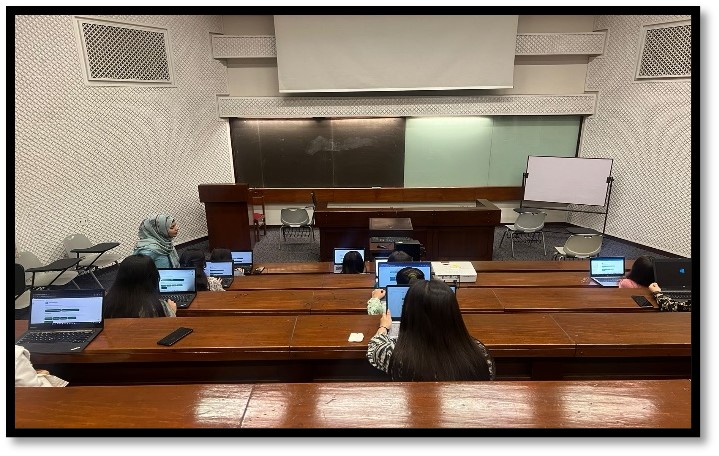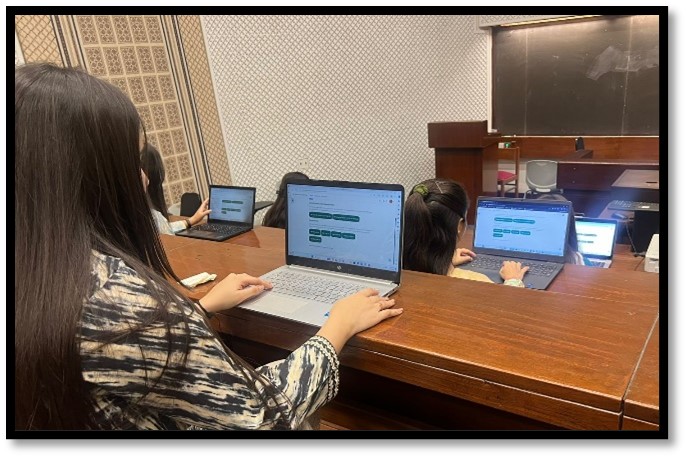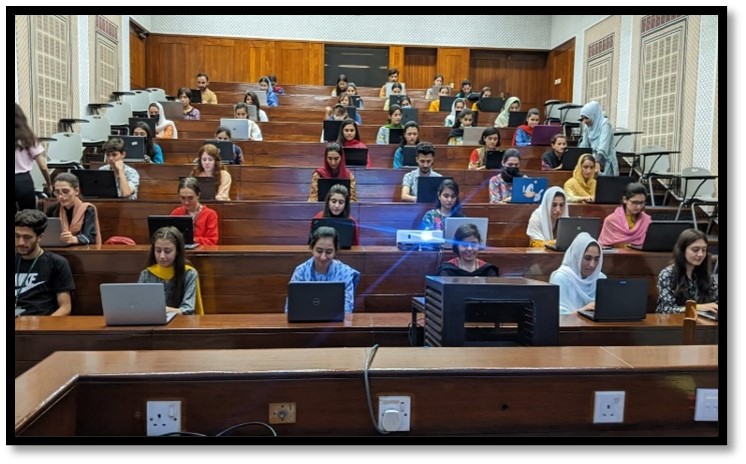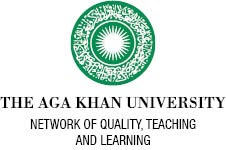Technophobia among undergraduate freshmen: a switch in assessment modality
Author: Tayyaba Shah | Teaching Associate | School of Nursing and Midwifery, Pakistan | The Aga Khan University
Introduction
The adoption of technology-based assessments aims for a more advanced, precise, and expedited approach to evaluating students, departing from traditional paper-based testing methods (Alruwais, Wills, & Wald, 2018), The Aga Khan University, School of Nursing and Midwifery (AKUSONAM) revamped assessment methods to elevate feedback quality, monitor student progress comprehensively across various assessments, and alleviate the faculty's workload in evaluating a large student number. At one aspect where they are employing unique security measures to verify students' identities, flexibility, and mitigate student cheating by implementing randomized question sequences, conversely, its increased usage in education has exerted an impact on students' psychological makeup, particularly their levels of technophobia "a severe nervousness related to doing anything technologically advanced"(O. Y. Khasawneh, 2018). Numerous research findings have reported technology-related anxiety and asserted that negative perceptions toward technology significantly influence online learning and have a significant impact on their ability to adopt new technology (Ajlouni & Rawadieh, 2022). Another study (O. Y. Khasawneh, 2023) evaluated the level of technophobia by using the O’Brien learning style questionnaire (O. Khasawneh, 2020) and the Davis technology acceptance model (Davis, 1985) and revealed moderate to high levels of technophobia among even Z-generation undergraduate students.
In addition to other online assessment modalities under practice at AKUSONAM, which includes the use of self-marking assessment tools, collaborative and feedback-oriented tools, the Umbrella Consortium for Assessment Networks (UCAN), Virtual learning Environment (VLE) and simulation-based assessment tools in Center for Innovation in Medical Education (CIME), used for training nursing students and the summative assessments are also conducted synchronously, using a customized web browser, the Safe Exam Browser (SEB) software that run on the university’s virtual learning environment platform. This web browser momentarily transforms any computer into a safe workstation. The screen gets locked, preventing students from opening other tabs, thus reducing the likelihood of plagiarism.
At AKUSONAM, the undergraduate BScN year-I freshmen encounter several adjustment issues including transition from college student to university student, anxiety, homesickness, peer pressure, and encountering a variety of technical innovative teaching and learning modalities. Apart from commonly occurring exam anxiety or "exam stress” introduction of technology-based assessment modality may add to their further stress. These apprehensions develop technophobia, affecting their overall performance as they fear failure in the use of technology, that they never had access to before, while writing the exam.
By taking technophobia in consideration, to reduce exam anxiety among freshmen, to provide the students hands-on experience with technical skills required for SEB software operationalization and to address common technophobia issues accompanied with providing answers to questions reported by students in previous semesters, rather than core subject knowledge which they already practice during review classes, a mock exam session was designed and conducted as a strategy for the BScN year 1 students before their first graded assessment. Mock examinations closely replicate the main exams in both content and cognitive demands (Amadioha & Uko, 2019). Ultimately, they serve as comprehensive practice sessions mirroring the actual exam conditions.
Implementation of Mock Exam Session
To provide hands-on experience to the students, a mock exam quiz was designed on VLE before the exam by using different data containing both subjective and objective questions. All the settings were adjusted using the same guidelines as of the real exam and quiz was linked with the SEB software which they were supposed to use during exams. The seating arrangements were similar to the exam hall. The whole class of 150 students were divided into 3 small groups of 50 students per group. Each session lasted for 30 minutes for each group.
Prior to the session, students were clearly shared with the basic instructions for the usage of SEB software as:
Download the latest SEB Setup file for mock test and install it on your laptop
Once logged into the VLE, click on the Assessments tab and download SEB configuration file entitled as “Test Mock march 9” it will redirect you to the VLE login page
Enter your User ID and passwords slowly (once)
After logging in, you will be directed to the exam page where instructions are listed
Read the instructions carefully and start exam with the given password in instructions
Once you logged in to SEB, your screen will be locked temporarily
Once you are done with exam, ask invigilators to unlock your screen then you can leave the exam hall
The facilitators reinforced the instructions about internet connectivity, SEB usage, and how a question should be attempted and troubleshooting in case of any freezing. Finally, the quiz was opened for students and all the facilitators were there for guidance. Out of 150 students, 101 students was successful in submitting the exam in allocated time while others had some technical issues in their gadgets, some required upgrading of software etc.

| 
|
Mock
exam tab inserted in the actual assessment section to make students learn the
navigation
|

BScN year-I students attempting the Mock exam test
|
Student’s Feedback
The students’ feedback reflected that the mock exam session was helpful in lowering student’s anxiety. The entire set-up, similar to examination hall, provided each student the opportunity to practice exam individually on the same modality as in real exam. The mock exam session had a significant impact in reducing their anxiety encoded by students as:
It helped me a lot because the browser was new to me, and I didn't know how to use that. This session has provided enough help.
It helped me understand the correct use of SEB, and the proper method of giving exams.
I had many queries about the exam and after the mock exam It was clear that what are we supposed to do, and it helped reduce the stress
It helped a lot. The mock test help in reducing anxiety and nervousness and helps in managing Time.
Mock tests prevent us from being panicky during opening our exam paper so that we don't lose focus by thinking that how we will get to the questions.
The mock test is very helpful for us. It prepared us 100% for exam.
Conclusion
Implementation of technology-based assessment in higher education could face some challenges. Different studies have investigated about these challenges including, less experienced student and teachers with computer or with the online assessment process, for which they need a training at the beginning to be equipped with digital literacy, technical proficiency, adaptability, operationalization and troubleshooting of the software and tools used in assessment (Osuji, 2012). The focus of this strategy was to introduce students to the processing of SEB software during assessments at AKUSONAM. The underlying assumption was to improve their academic performance by lowering their level of anxiety related to technology-based assessment modality. The students experienced minimum difficulty in using the web-browser during the actual exam; this endorses the effectiveness of the strategy.
Since technophobia might be associated with multiple technologies, providing supportive resources for one technology will not remove technophobia completely from users but it showed the positive impact and outcomes during execution of real exam as the students were feeling more confident in using SEB software which also enhanced their performance.
On the basis of the feedback obtained, the following recommendations are hereby made:
Mock examinations can be used as a diagnostic tool to reveal how well teachers' instructions have been mastered by students, prepare students for future examinations
Strategies should be developed to correct any misconceptions or difficulties of students causing anxiety, before the final examination.
Similar strategies can be adopted and used in almost every discipline where candidates are coming with diverse level of understandings and also whenever applying any new emerging modality for graded assessments to ensure students' comfort with processing, thereby improving their success rates.
Acknowledgment: Zohra Asif Jetha, Amber David, Wahab Sikandar, Sameen Rahat, Shagufta Iqbal, Dr Naghma Rizvi
References
- Adewumi, A. F., & Monisola, K. A. (2013). Continuous Assessment, Mock Results and Gender as Predictors of Academic Performance of Chemistry Students in WASSCE and NECO Examinations in Ekiti State. International Education Studies, 6(7), 1-8.
- Agostino, A. (1999). The relevance of media as artifact: Technology situated in context. Journal of Educational Technology & Society, 2(4), 46-52.
- Ajlouni, A. O., & Rawadieh, S. M. (2022). Technophobia and Technophilia among Undergraduates: Cross-national Research in Jordan, Qatar, and Egypt. Journal of Social Studies Education Research, 13(4), 24-55.
- Alruwais, N., Wills, G., & Wald, M. (2018). Advantages and challenges of using e-assessment. International Journal of Information and Education Technology, 8(1), 34-37.
- Amadioha, A., & Uko, B. E. (2019). Mock Examination As Predictor Of Academic Performance In Agricultural Science In Ikot Ekpene Senatorial District Of Akwa Ibom State. International Journal of Innovative Social & Science Education Research 7 (2): 49-53, April-June.
- Arbaugh, J. B. (2002). Managing the on-line classroom: A study of technological and behavioral characteristics of web-based MBA courses. The Journal of High Technology Management Research, 13(2), 203-223.
- Davis, F. D. (1985). A technology acceptance model for empirically testing new end-user information systems: Theory and results. Massachusetts Institute of Technology.
- District, B. C. I. S. (1998). Instructional Technology Across the Curriculum: Michigan's Technology Benchmarks Formatted for Teachers and Students: a Project: Berrien County Intermediate School District.
- Dotson, W. H. (2007). Effects of practice opportunities on exam performance in an undergraduate behavior modification course. University of Kansas.
- Gilbert, L., Whitelock, D., & Gale, V. (2011). Synthesis report on assessment and feedback with technology enhancement.
- Khasawneh, O. (2020). Technical knowledge and ability: Expectation verses reality the dunning-kruger effect. International Journal of Business Management and Commerce (5), 2, 21.
- Khasawneh, O. Y. (2018). Technophobia: Examining its hidden factors and defining it. Technology in Society, 54, 93-100.
- Khasawneh, O. Y. (2023). Technophobia: How students’ technophobia impacts their technology acceptance in an online class. International Journal of Human–Computer Interaction, 39(13), 2714-2723.
- Marriott, P. (2009). Students' evaluation of the use of online summative assessment on an undergraduate financial accounting module. British Journal of Educational Technology, 40(2), 237-254.
- Nichols, M. (2003). Using eLearning tools for assessment purposes. Paper presented at the 16th ODLAA Biennial Forum Conference Proceedings Sustaining Quality Learning Environments.
- Nicol, D. (2007). E‐assessment by design: using multiple‐choice tests to good effect. Journal of Further and higher Education, 31(1), 53-64.
- Osuji, U. S. (2012). The use of e-assessments in the Nigerian higher education system. Turkish Online Journal of Distance Education, 13(4), 140-152.
- Peterson, D. (2013). Five steps to better tests: Questionmark.
- Rarieya, J., Khamis, T., & Spowart, L. (2023). Transforming teaching & learning in higher education: Stories of impact from the Aga Khan University.


